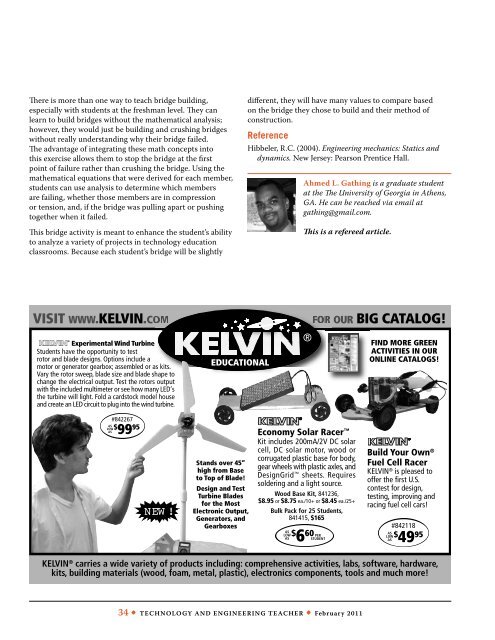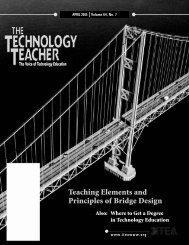K-12 Engineering Education Standards: - International Technology ...
K-12 Engineering Education Standards: - International Technology ...
K-12 Engineering Education Standards: - International Technology ...
You also want an ePaper? Increase the reach of your titles
YUMPU automatically turns print PDFs into web optimized ePapers that Google loves.
There is more than one way to teach bridge building,<br />
especially with students at the freshman level. They can<br />
learn to build bridges without the mathematical analysis;<br />
however, they would just be building and crushing bridges<br />
without really understanding why their bridge failed.<br />
The advantage of integrating these math concepts into<br />
this exercise allows them to stop the bridge at the first<br />
point of failure rather than crushing the bridge. Using the<br />
mathematical equations that were derived for each member,<br />
students can use analysis to determine which members<br />
are failing, whether those members are in compression<br />
or tension, and, if the bridge was pulling apart or pushing<br />
together when it failed.<br />
This bridge activity is meant to enhance the student’s ability<br />
to analyze a variety of projects in technology education<br />
classrooms. Because each student’s bridge will be slightly<br />
different, they will have many values to compare based<br />
on the bridge they chose to build and their method of<br />
construction.<br />
Reference<br />
Hibbeler, R.C. (2004). <strong>Engineering</strong> mechanics: Statics and<br />
dynamics. New Jersey: Pearson Prentice Hall.<br />
Ahmed L. Gathing is a graduate student<br />
at the The University of Georgia in Athens,<br />
GA. He can be reached via email at<br />
gathing@gmail.com.<br />
This is a refereed article.<br />
VISIT WWW.KELVIN.COM<br />
Experimental Wind Turbine<br />
Students have the opportunity to test<br />
rotor and blade designs. Options include a<br />
motor or generator gearbox; assembled or as kits.<br />
Vary the rotor sweep, blade size and blade shape to<br />
change the electrical output. Test the rotors output<br />
with the included multimeter or see how many LED’s<br />
the turbine will light. Fold a cardstock model house<br />
and create an LED circuit to plug into the wind turbine.<br />
EDUCATIONAL<br />
®<br />
FOR OUR BIG CATALOG!<br />
FIND MORE GREEN<br />
ACTIVITIES IN OUR<br />
ONLINE CATALOGS!<br />
#842267<br />
AS $<br />
99 95<br />
LOW<br />
AS<br />
NEW !<br />
Stands over 45”<br />
high from Base<br />
to Top of Blade!<br />
Design and Test<br />
Turbine Blades<br />
for the Most<br />
Electronic Output,<br />
Generators, and<br />
Gearboxes<br />
Economy Solar Racer <br />
Kit includes 200mA/2V DC solar<br />
cell, DC solar motor, wood or<br />
corrugated plastic base for body,<br />
gear wheels with plastic axles, and<br />
DesignGrid sheets. Requires<br />
soldering and a light source.<br />
Wood Base Kit, 84<strong>12</strong>36,<br />
$8.95 or $8.75 ea./10+ or $8.45 ea./25+<br />
Bulk Pack for 25 Students,<br />
841415, $165<br />
AS<br />
LOW<br />
AS<br />
$<br />
6 60<br />
PER<br />
STUDENT<br />
Build Your Own ®<br />
Fuel Cell Racer<br />
KELVIN ® is pleased to<br />
offer the first U.S.<br />
contest for design,<br />
testing, improving and<br />
racing fuel cell cars!<br />
#842118<br />
AS $<br />
49 95<br />
LOW<br />
AS<br />
KELVIN ® carries a wide variety of products including: comprehensive activities, labs, software, hardware,<br />
kits, building materials (wood, foam, metal, plastic), electronics components, tools and much more!<br />
34 • <strong>Technology</strong> and <strong>Engineering</strong> Teacher • February 2011
















